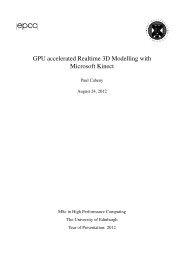MglLZA
MglLZA
MglLZA
You also want an ePaper? Increase the reach of your titles
YUMPU automatically turns print PDFs into web optimized ePapers that Google loves.
General Introduction to<br />
Parallel Computing<br />
Rezaul Chowdhury<br />
Department of Computer Science<br />
Stony Brook University
Why Parallelism?
Moore’s Law<br />
Source: Wikipedia
Unicore Performance<br />
Source: Jeff Preshing, 2012, http://preshing.com/20120208/a-look-back-at-single-threaded-cpu-performance/
Unicore Performance Has Hit a Wall!<br />
Some Reasons<br />
― Lack of additional ILP<br />
( Instruction Level Hidden Parallelism )<br />
― High power density<br />
― Manufacturing issues<br />
― Physical limits<br />
― Memory speed
Unicore Performance: No Additional ILP<br />
“Everything that can be invented has been invented.”<br />
Exhausted all ideas to exploit hidden parallelism?<br />
― Multiple simultaneous instructions<br />
― Instruction Pipelining<br />
― Out-of-order instructions<br />
― Speculative execution<br />
― Branch prediction<br />
— Charles H. Duell<br />
Commissioner, U.S. patent office, 1899<br />
― Register renaming, etc.
Unicore Performance: High Power Density<br />
― Dynamic power, P d V 2 f C<br />
― But V f<br />
―<br />
―<br />
―<br />
V = supply voltage<br />
f = clock frequency<br />
C = capacitance<br />
― Thus P d f 3<br />
Source: Patrick Gelsinger, Intel Developer Forum, Spring 2004 ( Simon Floyd )
Unicore Performance: Manufacturing Issues<br />
― Frequency, f 1 / s<br />
― s = feature size ( transistor dimension )<br />
― Transistors / unit area 1 / s 2<br />
― Typically, die size 1 / s<br />
― So, what happens if feature size goes down by a factor of x?<br />
― Raw computing power goes up by a factor of x 4 !<br />
― Typically most programs run faster by a factor of x 3<br />
without any change!<br />
Source: Kathy Yelick and Jim Demmel, UC Berkeley
Unicore Performance: Manufacturing Issues<br />
― Manufacturing cost goes up as feature size decreases<br />
―<br />
Cost of a semiconductor fabrication plant doubles<br />
every 4 years ( Rock’s Law )<br />
― CMOS feature size is limited to 5 nm ( at least 10 atoms )<br />
Source: Kathy Yelick and Jim Demmel, UC Berkeley
Unicore Performance: Physical Limits<br />
Execute the following loop on a serial machine in 1 second:<br />
for ( i = 0; i < 10 12 ; ++i )<br />
z[ i ] = x[ i ] + y[ i ];<br />
― We will have to access 3×10 12 data items in one second<br />
― Speed of light is, c 3×10 8 m/s<br />
― So each data item must be within c / 3×10 12 0.1 mm<br />
from the CPU on the average<br />
― All data must be put inside a 0.2 mm × 0.2 mm square<br />
― Each data item ( ≥ 8 bytes ) can occupy only 1 Å 2 space!<br />
( size of a small atom! )<br />
Source: Kathy Yelick and Jim Demmel, UC Berkeley
Unicore Performance: Memory Wall<br />
Source: Rick Hetherington, Chief Technology Officer, Microelectronics, Sun Microsystems
Unicore Performance Has Hit a Wall!<br />
Some Reasons<br />
― Lack of additional ILP<br />
( Instruction Level Hidden Parallelism )<br />
― High power density<br />
― Manufacturing issues<br />
― Physical limits<br />
― Memory speed<br />
“Oh Sinnerman, where you gonna run to?”<br />
— Sinnerman ( recorded by Nina Simone )
Where You Gonna Run To?<br />
― Changing f by 20% changes performance by 13%<br />
― So what happens if we overclock by 20%?<br />
Source: Andrew A. Chien, Vice President of Research, Intel Corporation
Where You Gonna Run To?<br />
― Changing f by 20% changes performance by 13%<br />
― So what happens if we overclock by 20%?<br />
― And underclock by 20%?<br />
Source: Andrew A. Chien, Vice President of Research, Intel Corporation
Where You Gonna Run To?<br />
― Changing f by 20% changes performance by 13%<br />
― So what happens if we overclock by 20%?<br />
― And underclock by 20%?<br />
Source: Andrew A. Chien, Vice President of Research, Intel Corporation
Moore’s Law Reinterpreted<br />
Source: Report of the 2011 Workshop on Exascale Programming Challenges
Top 500 Supercomputing Sites ( Cores / Socket )<br />
Source: www.top500.org
No Free Lunch for Traditional Software<br />
Source: Simon Floyd, Workstation Performance: Tomorrow's Possibilities (Viewpoint Column)
A Useful Classification<br />
of Parallel Computers
Parallel Computer Memory Architecture<br />
( Distributed Memory )<br />
― Each processor has its own<br />
local memory ― no global<br />
address space<br />
― Changes in local memory by<br />
one processor have no effect<br />
on memory of other processors<br />
Source: Blaise Barney, LLNL<br />
― Communication network to connect inter-processor memory<br />
― Programming<br />
― Message Passing Interface ( MPI )<br />
―<br />
Many once available: PVM, Chameleon, MPL, NX, etc.
Parallel Computer Memory Architecture<br />
( Shared Memory )<br />
― All processors access all memory<br />
as global address space<br />
― Changes in memory by one<br />
processor are visible to all others<br />
― Two types<br />
―<br />
―<br />
Uniform Memory Access<br />
( UMA )<br />
Non-Uniform Memory Access<br />
( NUMA )<br />
UMA<br />
― Programming<br />
― Open Multi-Processing ( OpenMP )<br />
―<br />
―<br />
Cilk/Cilk++ and Intel Cilk Plus<br />
Intel Thread Building Block ( TBB ), etc.<br />
NUMA<br />
Source: Blaise Barney, LLNL
Parallel Computer Memory Architecture<br />
( Hybrid Distributed-Shared Memory )<br />
― The share-memory component<br />
can be a cache-coherent SMP or<br />
a Graphics Processing Unit (GPU)<br />
― The distributed-memory<br />
component is the networking of<br />
multiple SMP/GPU machines<br />
― Most common architecture<br />
for the largest and fastest<br />
computers in the world today<br />
― Programming<br />
―<br />
OpenMP / Cilk + CUDA / OpenCL + MPI, etc.<br />
Source: Blaise Barney, LLNL
Types of Parallelism
Nested Parallelism<br />
int comb ( int n, int r )<br />
{<br />
if ( r > n ) return 0;<br />
if ( r == 0 || r == n ) return 1;<br />
}<br />
Control cannot pass this point<br />
until all spawned children have<br />
returned.<br />
int x, y;<br />
x = comb( n – 1, r - 1 );<br />
y = comb( n – 1, r );<br />
return ( x + y );<br />
int comb ( int n, int r )<br />
{<br />
if ( r > n ) return 0;<br />
if ( r == 0 || r == n ) return 1;<br />
int x, y;<br />
x = spawn comb( n – 1, r - 1 );<br />
y = comb( n – 1, r );<br />
sync;<br />
Serial Code<br />
Grant permission to execute<br />
the called ( spawned ) function<br />
in parallel with the caller.<br />
}<br />
return ( x + y );<br />
Parallel Code
Loop Parallelism<br />
in-place<br />
transpose<br />
Allows all iterations of the loop<br />
to be executed in parallel.<br />
for ( int i = 1; i < n; ++i )<br />
for ( int j = 0; j < i; ++j )<br />
{<br />
double t = A[ i ][ j ];<br />
A[ i ][ j ] = A[ j ][ i ];<br />
}<br />
A[ j ][ i ] = t;<br />
Serial Code<br />
Can be converted to spawns and syncs<br />
using recursive divide-and-conquer.<br />
parallel for ( int i = 1; i < n; ++i )<br />
for ( int j = 0; j < i; ++j )<br />
{<br />
double t = A[ i ][ j ];<br />
A[ i ][ j ] = A[ j ][ i ];<br />
A[ j ][ i ] = t;<br />
}<br />
Parallel Code
Analyzing<br />
Parallel Algorithms
Speedup<br />
Let T p = running time using p identical processing elements<br />
Speedup, S p = T 1<br />
T p<br />
Theoretically, S p ≤ p<br />
Perfect or linear or ideal speedup if S p = p
Source: Grama et al., “Introduction to Parallel Computing”, 2 nd Edition<br />
Speedup<br />
Consider adding n numbers<br />
using n identical processing<br />
elements.<br />
Serial runtime, T = n<br />
Parallel runtime, T n = log n<br />
Speedup, S n = T 1<br />
T n<br />
= <br />
n<br />
log n
Parallelism & Span Law<br />
We defined, T p = runtime on p identical processing elements<br />
Then span, T ∞ = runtime on an infinite number of identical<br />
processing elements<br />
Parallelism, P = T 1<br />
T ∞<br />
Parallelism is an upper bound on speedup, i.e., S p ≤ P<br />
Span Law<br />
T p ≥ T ∞
Work Law<br />
The cost of solving ( or work performed for solving ) a problem:<br />
On a Serial Computer: is given by T 1<br />
On a Parallel Computer: is given by pT p<br />
Work Law<br />
T p ≥ T 1<br />
p
Bounding Parallel Running Time ( T p )<br />
A runtime/online scheduler maps tasks to processing elements<br />
dynamically at runtime.<br />
A greedy scheduler never leaves a processing element idle if it can<br />
map a task to it.<br />
Theorem [ Graham’68, Brent’74 ]: For any greedy scheduler,<br />
T p T 1<br />
p + T <br />
Corollary: For any greedy scheduler,<br />
where T p ∗ is the running time due to optimal scheduling on p<br />
processing elements.<br />
T p ≤ 2T p ∗ ,
Analyzing Parallel<br />
Matrix Multiplication
Parallel Iterative MM<br />
Iter-MM ( Z, X, Y )<br />
1. for i 1 to n do<br />
{ X, Y, Z are n × n matrices,<br />
where n is a positive integer }<br />
2. for j 1 to n do<br />
3. Z[ i ][ j ] 0<br />
4. for k 1 to n do<br />
5. Z[ i ][ j ] Z[ i ][ j ] + X[ i ][ k ] Y[ k ][ j ]<br />
Par-Iter-MM ( Z, X, Y )<br />
1. parallel for i 1 to n do<br />
2. parallel for j 1 to n do<br />
3. Z[ i ][ j ] 0<br />
4. for k 1 to n do<br />
{ X, Y, Z are n × n matrices,<br />
where n is a positive integer }<br />
5. Z[ i ][ j ] Z[ i ][ j ] + X[ i ][ k ] Y[ k ][ j ]
Parallel Iterative MM<br />
Par-Iter-MM ( Z, X, Y )<br />
1. parallel for i 1 to n do<br />
2. parallel for j 1 to n do<br />
3. Z[ i ][ j ] 0<br />
4. for k 1 to n do<br />
{ X, Y, Z are n × n matrices,<br />
where n is a positive integer }<br />
5. Z[ i ][ j ] Z[ i ][ j ] + X[ i ][ k ] Y[ k ][ j ]<br />
Work: T 1 n = n 3<br />
Span: T ∞ n = n<br />
Parallel Running Time: T p n = T 1 n<br />
p + T ∞ n = n3<br />
p + n<br />
Parallelism: T 1 n<br />
T ∞ n<br />
= n2
Z<br />
Parallel Recursive MM<br />
X<br />
Y<br />
n/2<br />
n/2<br />
n/2<br />
n/2 Z 11<br />
Z 21<br />
Z 12<br />
Z 22<br />
n<br />
<br />
n/2 X 11<br />
X 21<br />
X 12<br />
X 22<br />
n<br />
<br />
n/2 Y 11<br />
Y 21<br />
Y 12<br />
Y 22<br />
n<br />
n<br />
n<br />
n<br />
n/2<br />
<br />
n/2 X 11 Y 11 + X 12 Y 21<br />
X 21 Y 11 + X 22 Y 21<br />
X 11 Y 12 + X 12 Y 22<br />
X 21 Y 12 + X 22 Y 22<br />
n<br />
n
Parallel Recursive MM<br />
Par-Rec-MM ( Z, X, Y )<br />
1. if n = 1 then<br />
2. Z Z + X Y<br />
3. else<br />
{ X, Y, Z are n × n matrices,<br />
where n = 2 k for integer k 0 }<br />
4. spawn Par-Rec-MM ( Z 11 , X 11 , Y 11 )<br />
5. spawn Par-Rec-MM ( Z 12 , X 11 , Y 12 )<br />
6. spawn Par-Rec-MM ( Z 21 , X 21 , Y 11 )<br />
7. Par-Rec-MM ( Z 21 , X 21 , Y 12 )<br />
8. sync<br />
9. spawn Par-Rec-MM ( Z 11 , X 12 , Y 21 )<br />
10. spawn Par-Rec-MM ( Z 12 , X 12 , Y 22 )<br />
11. spawn Par-Rec-MM ( Z 21 , X 22 , Y 21 )<br />
12. Par-Rec-MM ( Z 22 , X 22 , Y 22 )<br />
13. sync<br />
14. endif
Parallel Recursive MM<br />
Par-Rec-MM ( Z, X, Y )<br />
1. if n = 1 then<br />
2. Z Z + X Y<br />
3. else<br />
{ X, Y, Z are n × n matrices,<br />
where n = 2 k for integer k 0 }<br />
Work:<br />
T 1 n =<br />
1 , if n = 1,<br />
n<br />
8T 1<br />
2 + 1 , otherwise.<br />
= n 3<br />
4. spawn Par-Rec-MM ( Z 11 , X 11 , Y 11 )<br />
5. spawn Par-Rec-MM ( Z 12 , X 11 , Y 12 )<br />
6. spawn Par-Rec-MM ( Z 21 , X 21 , Y 11 )<br />
7. Par-Rec-MM ( Z 21 , X 21 , Y 12 )<br />
8. sync<br />
9. spawn Par-Rec-MM ( Z 11 , X 12 , Y 21 )<br />
10. spawn Par-Rec-MM ( Z 12 , X 12 , Y 22 )<br />
11. spawn Par-Rec-MM ( Z 21 , X 22 , Y 21 )<br />
12. Par-Rec-MM ( Z 22 , X 22 , Y 22 )<br />
13. sync<br />
14. endif<br />
Span:<br />
T ∞ n =<br />
= n<br />
Parallelism: T 1 n<br />
T ∞ n<br />
Additional Space:<br />
s ∞ n = 1<br />
1 , if n = 1,<br />
2T ∞<br />
n<br />
2 + 1 , otherwise.<br />
= n2
n/2<br />
Recursive MM with More Parallelism<br />
Z<br />
n/2<br />
n/2 Z 11<br />
Z 21<br />
Z 12<br />
Z 22<br />
n<br />
<br />
n/2 X 11 Y 11 + X 12 Y 21<br />
X 21 Y 11 + X 22 Y 21<br />
X 11 Y 12 + X 12 Y 22<br />
X 21 Y 12 + X 22 Y 22<br />
n<br />
n<br />
n<br />
n/2<br />
n/2<br />
<br />
n/2 X 11 Y 11<br />
X 21 Y 11<br />
X 11 Y 12<br />
X 21 Y 12<br />
n<br />
<br />
n/2 X 12 Y 21<br />
X 12 Y 22<br />
X 22 Y 21 X 22 Y 22<br />
n<br />
n<br />
n
Recursive MM with More Parallelism<br />
Par-Rec-MM2 ( Z, X, Y )<br />
1. if n = 1 then<br />
{ X, Y, Z are n × n matrices,<br />
where n = 2 k for integer k 0 }<br />
2. Z Z + X Y<br />
3. else { T is a temporary n n matrix }<br />
4. spawn Par-Rec-MM2 ( Z 11 , X 11 , Y 11 )<br />
5. spawn Par-Rec-MM2 ( Z 12 , X 11 , Y 12 )<br />
6. spawn Par-Rec-MM2 ( Z 21 , X 21 , Y 11 )<br />
7. spawn Par-Rec-MM2 ( Z 21 , X 21 , Y 12 )<br />
8. spawn Par-Rec-MM2 ( T 11 , X 12 , Y 21 )<br />
9. spawn Par-Rec-MM2 ( T 12 , X 12 , Y 22 )<br />
10. spawn Par-Rec-MM2 ( T 21 , X 22 , Y 21 )<br />
11. Par-Rec-MM2 ( T 22 , X 22 , Y 22 )<br />
12. sync<br />
13. parallel for i 1 to n do<br />
14. parallel for j 1 to n do<br />
15. Z[ i ][ j ] Z[ i ][ j ] + T[ i ][ j ]<br />
16. endif
Recursive MM with More Parallelism<br />
Par-Rec-MM2 ( Z, X, Y )<br />
1. if n = 1 then<br />
2. Z Z + X Y<br />
{ X, Y, Z are n × n matrices,<br />
where n = 2 k for integer k 0 }<br />
3. else { T is a temporary n n matrix }<br />
4. spawn Par-Rec-MM2 ( Z 11 , X 11 , Y 11 )<br />
5. spawn Par-Rec-MM2 ( Z 12 , X 11 , Y 12 )<br />
6. spawn Par-Rec-MM2 ( Z 21 , X 21 , Y 11 )<br />
7. spawn Par-Rec-MM2 ( Z 21 , X 21 , Y 12 )<br />
8. spawn Par-Rec-MM2 ( T 11 , X 12 , Y 21 )<br />
9. spawn Par-Rec-MM2 ( T 12 , X 12 , Y 22 )<br />
10. spawn Par-Rec-MM2 ( T 21 , X 22 , Y 21 )<br />
11. Par-Rec-MM2 ( T 22 , X 22 , Y 22 )<br />
12. sync<br />
13. parallel for i 1 to n do<br />
14. parallel for j 1 to n do<br />
15. Z[ i ][ j ] Z[ i ][ j ] + T[ i ][ j ]<br />
16. endif<br />
Work:<br />
T 1 n =<br />
Span:<br />
T ∞ n =<br />
s ∞ n =<br />
1 , if n = 1,<br />
n<br />
8T 1<br />
2 + n2 , otherwise.<br />
= n 3<br />
1 , if n = 1,<br />
n<br />
+ log n , otherwise.<br />
2<br />
T ∞<br />
= log 2 n<br />
Parallelism: T 1 n<br />
T ∞ n = n3<br />
log 2 n<br />
Additional Space:<br />
1 , if n = 1,<br />
8s ∞<br />
n<br />
2 + n2 , otherwise.<br />
= n 3
Distributed-Memory Naïve Matrix Multiplication<br />
z<br />
n<br />
<br />
x y<br />
ij ik kj<br />
k1<br />
Iter-MM ( X, Y, Z, n )<br />
1. for i 1 to n do<br />
2. for j 1 to n do<br />
3. for k 1 to n do<br />
4. z ij z ij + x ik y kj
Distributed-Memory Naïve Matrix Multiplication<br />
z<br />
n<br />
x y<br />
ij ik kj<br />
k1<br />
Suppose we have p = n × n processors, and processor P ij is<br />
responsible for computing z ij .<br />
Let’s assume that one master processor initially holds both X and Y.<br />
Each processor in the group {P i,1 , P i,2 , … , P i,n } will require row i of X.<br />
Similarly, for other rows of X, and all columns of Y.<br />
Each P ij computes z ij and sends back to master.
Distributed-Memory Naïve Matrix Multiplication<br />
z<br />
n<br />
x y<br />
ij ik kj<br />
k1<br />
Let t s be the startup time of a message, and<br />
t w be the per-word transfer time.<br />
The communication complexity of broadcasting m units of data to a<br />
group of size n is t s + mt w<br />
log n.<br />
Communication complexity of sending one unit of data back to<br />
master is t s + t w .<br />
Hence, t comm ≤ 2n t s + nt w log n + n 2 t s + t w .<br />
Also t comp = 2n.<br />
Finally, T p = t comp + t comm .<br />
The log n factor<br />
vanishes because<br />
of pipelining
Scaling Laws
Scaling of Parallel Algorithms<br />
( Amdahl’s Law )<br />
Suppose only a fraction f of a computation can be parallelized.<br />
Then parallel running time, T p ≥ 1 − f T 1 + f T 1<br />
Speedup, S p = T 1<br />
T p<br />
≤<br />
p<br />
= 1<br />
f+ 1−f p 1−f + f p<br />
≤ 1<br />
1−f<br />
p
Scaling of Parallel Algorithms<br />
( Amdahl’s Law )<br />
Suppose only a fraction f of a computation can be parallelized.<br />
Speedup, S p = T 1<br />
T p<br />
≤<br />
1<br />
1−f + f p<br />
≤ 1<br />
1−f<br />
Source: Wikipedia
Source: Martha Kim, Columbia University<br />
Strong Scaling vs. Weak Scaling<br />
Strong Scaling<br />
How T p ( or S p ) varies with p when the problem size is fixed.<br />
Weak Scaling<br />
How T p ( or S p ) varies with p when the problem size per<br />
processing element is fixed.
Source: Grama et al.,<br />
“Introduction to Parallel Computing”,<br />
2 nd Edition<br />
Efficiency, E p = S p<br />
p = T 1<br />
pT p<br />
Scalable Parallel Algorithms<br />
A parallel algorithm is called scalable if its efficiency can be<br />
maintained at a fixed value by simultaneously increasing the number<br />
of processing elements and the problem size.<br />
Scalability reflects a parallel algorithm’s ability to utilize increasing<br />
processing elements effectively.
“We used to joke that<br />
“parallel computing is the future, and always will be,”<br />
but the pessimists have been proven wrong.”<br />
— Tony Hey<br />
Now Have Fun!


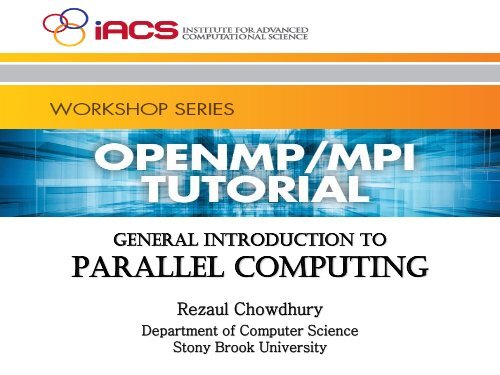

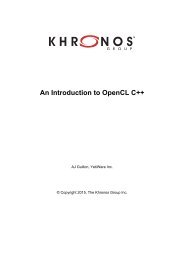
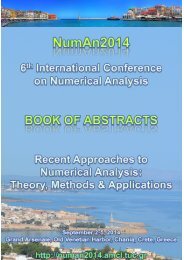

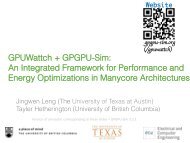
![arXiv:1305.1183v1 [cs.DC] 6 May 2013](https://img.yumpu.com/14598982/1/190x245/arxiv13051183v1-csdc-6-may-2013.jpg?quality=85)
